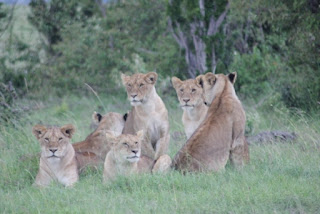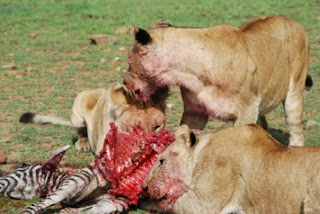I enjoy listening to the guys at camp talk about life and animals. I think there is value in traditional knowledge that stems from experiences and cultures that are tied to nature. As a visitor I have not been here long enough to either believe or disbelieve their wisdom, but I have been writing it down to retell.
The clever ways of animals in the Mara as told by a few Masai...
- Jackals follow lions to eat their cubs.
- Hyenas put desiccated carcasses in water and return to a rehydrated softened meal.
- Baboons chase cheetahs off kills.
- Leopards remove the guts of kills in the tree to preserve the meat…eating first some of the intestine, which is hung on a different branch than the rest of the carcass.
- Giraffes are polite.
- Lions will pounce on a baby elephant while the mother is off feeding, urinate on it and then retreat to sit and wait. When the mother elephant returns it will beat the baby because of an association with the lion smell…then the baby will run and the lions will attempt to kill the baby once away from the mother elephant.
- Crocs won’t eat a cheetah that swims across the river.
- Nothing eats waterbuck because they have too many tendons and it chokes the predator.
I am not sure how regular any of these scenarios are in the wild. I still have not seen enough of the Mara to contribute much insight. Similarly after the past few months of hyena work I am uncertain if I should believe or disbelieve what I have observed and heard.
For example, ask almost anyone if spotted hyenas are nothing more than scavengers and they will tell you…
A group of 4 lions encircled and chased a herd of zebra back into three crouching waiting lions, which then pounced on and killed two juvenile zebras. After the lions had fed for a few minutes, a rally call of whoops preceded the bristle tail arrival of hyenas. Approximately 30+ hyenas showed up and the lions were forced off one zebra carcass. (Pictures courtesy Noemie Lamon)
Not long after the cheetah disembowled its kill, a hyena (not from one of the clans that we study), catches wind of the dead gazelle. With no more than a half-hearted paw swat of resistance, the cheetah watched is breakfast walk away.
Since I have been in the Mara I have seen two successful hyena kills. I have seen numerous hyenas at kills (responsible killer unknown), and there have been multiple occasions where hyenas have stolen food from some other carnivore. My experience lends to a strong propensity that spotted hyenas are primarily scavengers, but for a less inhibited account of spotted hyena feeding ecology see the combined years of observations detailed in Kruuk 1972 and Holekamp et al 1997 (among others).
In addition to feeding patterns, other aspects of hyena ecology have not forthright unveiled their truth to me. An accurate delineation of a clan social hierarchy is another example of a pattern in nature that is best observed over a significant amount of time; arguably longer than the 9.5 months that I have been in the Mara. Take for example the organization of adult female rank for the Serena North clan … on paper it breaks down as such (highest rank to lowest rank, left to right):
RBC-->ZOEY-->SHRM-->SAU-->ANGI-->DIGS-->PEEP-->ARRO… and near the bottom AWP or some other invariably tattered eared low rank female.
This organization is not so clear in the field…
On August 31st, 2011, RBC (supposed highest rank) was at a location with a number of her offspring, along with DIGS (supposed 6th rank) and number of her offspring; all loosely associated around a small piece of food scrap. More importantly, the following transcription excerpts precipitate the fact that both RBC and DIGS were present and able to reinforce any rank discrepancies if they had occurred among their offspring. Furthermore, the rank associations of a youngest offspring outranking older offspring within a mother’s lineage, was upheld at this session; suggesting that these interactions were not altogether an outlier.
1839 MARI app t1 lk (fd) t1 st ov (fd) TYPH, eb oma
MARI t2 lunge (fd) TYPH, eb def parry bo
(In the interaction at 1829, MARI [DIGS cub who was about 1 year old] aggresses on TYPH [RBC’s cub who was also about 1 year old] and TYPH submits.)
1843 DIGS st t1 lk (pesky) t1 pt (pesky) SANA, eb bo
SANA app t1 st ov (fd, scape) brt t2 chase (fd, scape) TYPH, stop fd scrap eb lope bo squeal
(A few minutes later DIGS aggresses on her older offspring SANA, who transfers that aggression to TYPH in a scape-goating reaction…RBC still did not to intervene)
1851 SANA TYPH coal brt t1 st ov (fd) SHRK, eb brt squeal bo
SHRK app t1 st ov/pt (scape) t1 displ (scape) STON, eb bo
SANA t1 lk (fd) SHRK, eb bo w/ fd
(At 1851 SHRK [who is most likely RBC’s offspring, older than TYPH] arrives and is aggressed on by SANA and TYPH…and this causes SHRK to scape goat on the un-involved cub STON [STON’s mother is of low rank].
1859 TYPH app brt t1 st ov (fd) SHRK, eb gig av w/ fd
TYPH brt t2 chase (fd) SHRK, eb av w/ fd
(Finally at 1859 I saw TYPH aggressing on SHRK who responded submissively and this suggested that age related rank of mother’s offspring was being upheld.)
Coming away from the session on August 31, 2011, it would seem that DIGS was of higher rank than RBC. On November 1, 2011 the North clan social structure was further disrupted. During this session SHRM’s lineage was involved in a number of aggressions with other high-ranking females while I was at the communal den. The important individuals to note in the following excerpts are SNIP, who is SHRM’s youngest cub, and HKR, SHRM’s adult female offspring.
0705 HKR groan app t1 st ov (unk) RBC, eb snf
RBC eb grm phallus HKR, groan ll
SNIP app snf RBC, eb sp
SNIP t1 pt (unk) RBC, eb
HKR join in t1 pt (unk) RBC, eb
(Simply put HKR and SNIP aggress on RBC, who submits…that seemed unlikely if RBC was the clan matriarch)
0709 HKR groan app t1 pt (unprov) ZOEY, eb sp
HKR groan snf ZOEY, eb sp bo
HKR SNIP coal brt t1 pt (unprov) ZOEY, eb
(Again if SHRM was the 3rd highest ranking adult female, it should not be that SHRM’s offspring would be able to aggress on and cause ZOEY to submit, who is ranked number two.)
Highest to lowest rank revised…
…SHRM-->ZOEY/DIGS-->RBC?--> other North clan females in some unknown rank order. That all makes about as much sense as the time I recently saw RBC, in what seemed to be an act of food provisioning to DIGS. At this point in time if any bets are called my money goes to the ‘lions-urinating-on-baby-elephants scenario’ as the most predictable odds.
The more familiar I have become with the North clan, the less I know. Happy Zebra however, after having gone missing for months and losing their matriarch, now seems to be falling effortlessly into a stable social hierarchy.
After previously observing COEL’s displacement from rightful matriarch as KOI’s youngest daughter and heir to dominance, it was still uncertain whether SNAP or PIKE (KOI’s older daughters) would be the newest dominant female in Happy Zebra. On November 30th PIKE arrived at the communal den and after greeting with an excited SNAP, PIKE proceeded to aggress on SNAP. Not only did SNAP submit to PIKE’s aggression, but SNAP was then aggressed on and bitten by BOOM (PIKE’s oldest female offspring), to which SNAP again responded submissively. In each following interaction, PIKE and BOOM succeeded in dominance over SNAP, who was left to vent her aggression on a few other lower ranking individuals at the den. These first observations of the social reorganization of Happy Zebra are little more than glance at the possible hierarchy delineation. But after a number of observation sessions around the communal den, I would say that I am now sure that PIKE is the dominant hyena in Happy Zebra clan.
I was also sure this would be last picture of BARR taken after KOI (BARR's mom) died.
Coming up on six months since last seen, BARR, was about to be moved into the missing or presumed dead category…
BARR with two of the newest hyena cubs from Happy Zebra clan.
BARR with two of the newest hyena cubs from Happy Zebra clan.
…welcome back BARR
In my last days in the Mara I would do best by remembering that, ‘…studying spotted hyenas requires an open mind and a willingness to recognize that, in the natural world, things are not always what they seem’ (http://scientistatwork.blogs.nytimes.com/2011/06/21/why-study-hyenas/#more-11367).
I would agree that even with careful observation, what we see and experience in nature is rarely straightforward, and that may be the only validated thing I have yet posted…of that I am sure.
























No comments:
Post a Comment